Abstract
We screened mini-Mu plasmid libraries from Enterobacter aerogenes IFO 12010 for plasmids that complement Escherichia coli phn mutants that cannot use phosphonates (Pn) as the sole source of phosphorus (P). We isolated two kinds of plasmids that, unexpectedly, encode genes for different metabolic pathways. One kind complements E. coli mutants with both Pn transport and Pn catalysis genes deleted; these plasmids allow degradation of the 2-carbon-substituted Pn alpha-aminoethylphosphonate but not of unsubstituted alkyl Pn. This substrate specificity is characteristic of a phosphonatase pathway, which is absent in E. coli. The other kind complements E. coli mutants with Pn catalysis genes deleted but not those with both transport and catalysis genes deleted; these plasmids allow degradation of both substituted and unsubstituted Pn. Such a broad substrate specificity is characteristic of a carbon-phosphorus (C-P) lyase pathway, which is common in gram-negative bacteria, including E. coli. Further proof that the two kinds of plasmids encode genes for different pathways was demonstrated by the lack of DNA homology between the plasmids. In particular, the phosphonatase clone from E. aerogenes failed to hybridize to the E. coli phnCDEFGHIJKLMNOP gene cluster for Pn uptake and degradation, while the E. aerogenes C-P lyase clone hybridized strongly to the E. coli phnGHIJKLM genes encoding C-P lyase but not to the E. coli phnCDE genes encoding Pn transport. Specific hybridization by the E. aerogenes C-P lyase plasmid to the E. coli phnF, phnN, phnO, and phnP genes was not determined. Furthermore, we showed that one or more genes encoding the apparent E. aerogenes phosphonatase pathway, like the E. coli phnC-to-phnP gene cluster, is under phosphate regulon control in E. coli. This highlights the importance of Pn in bacterial P assimilation in nature.
Full text
PDF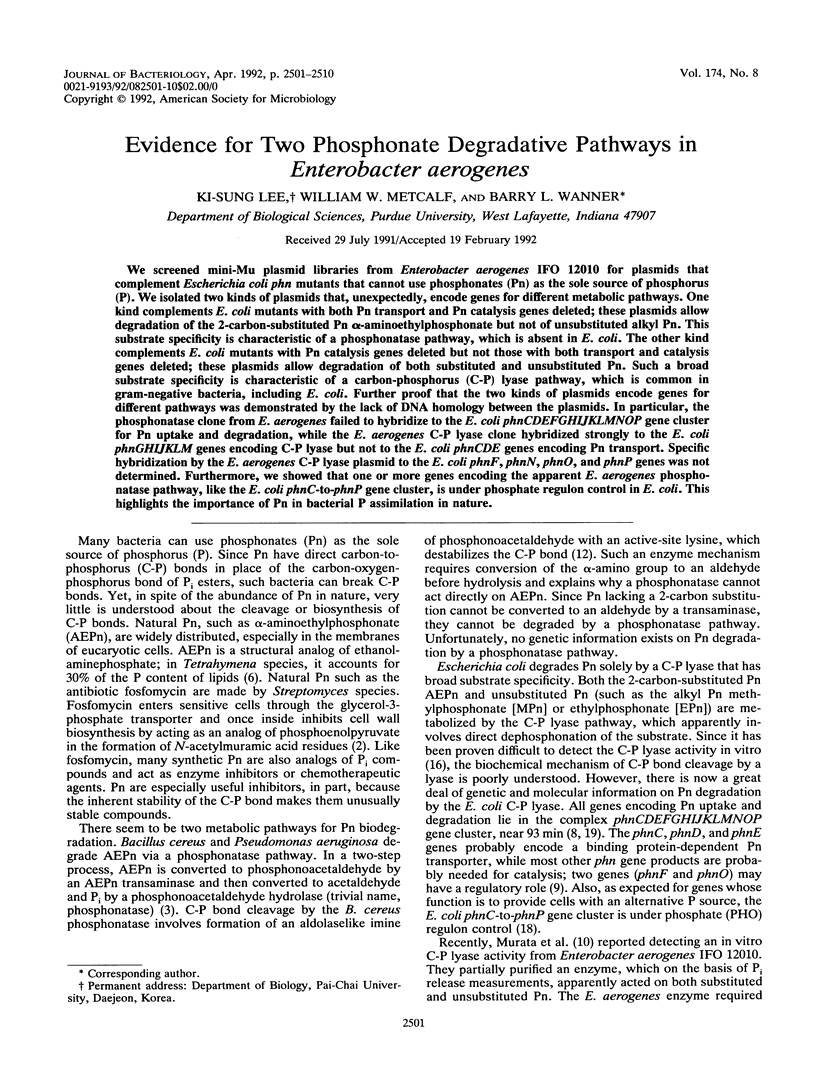
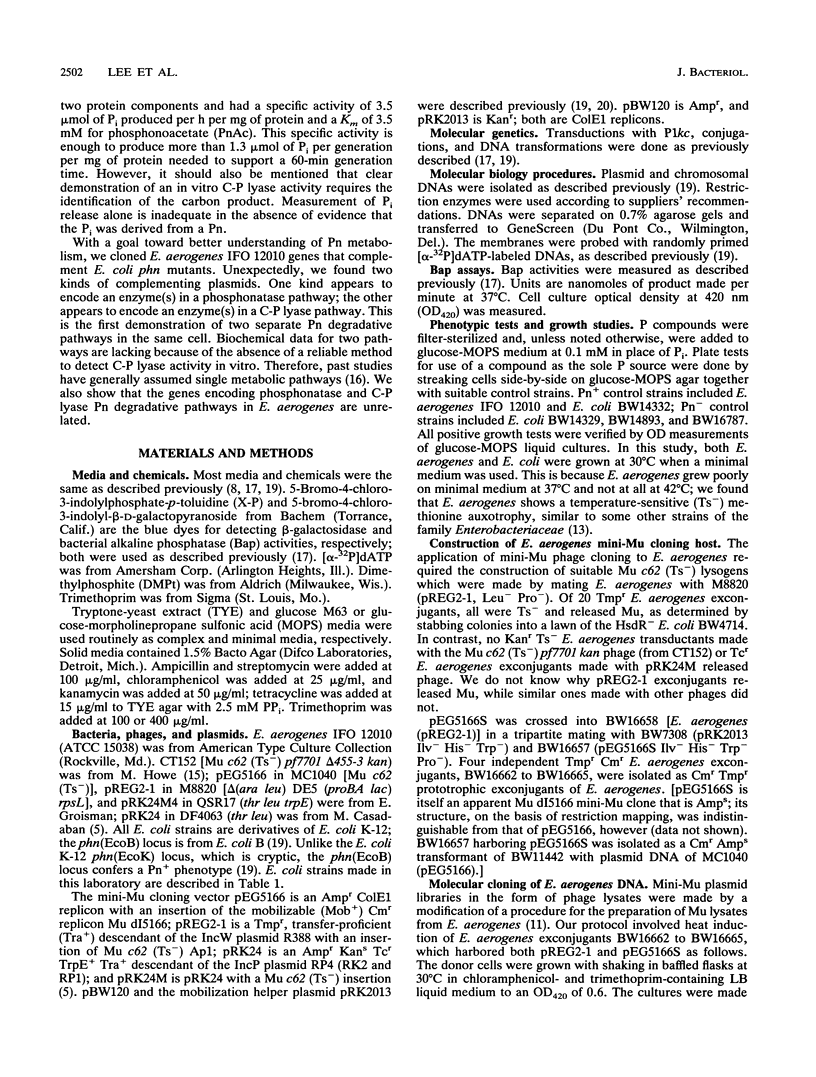
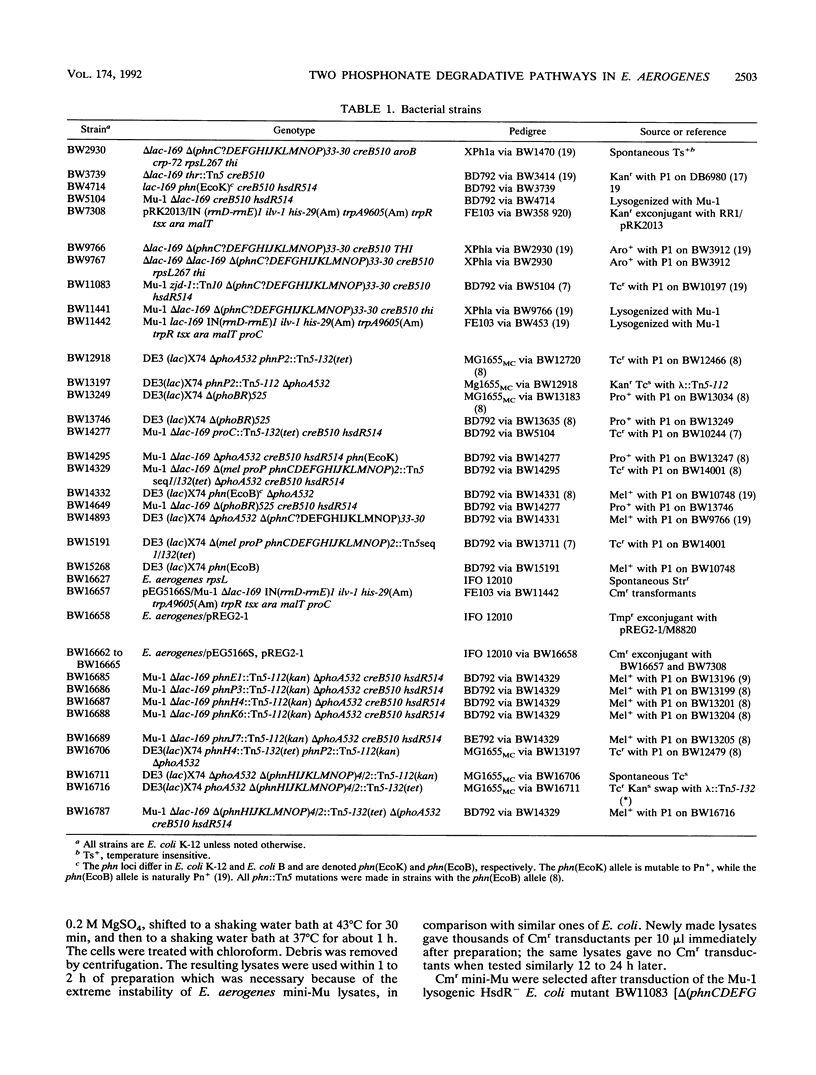
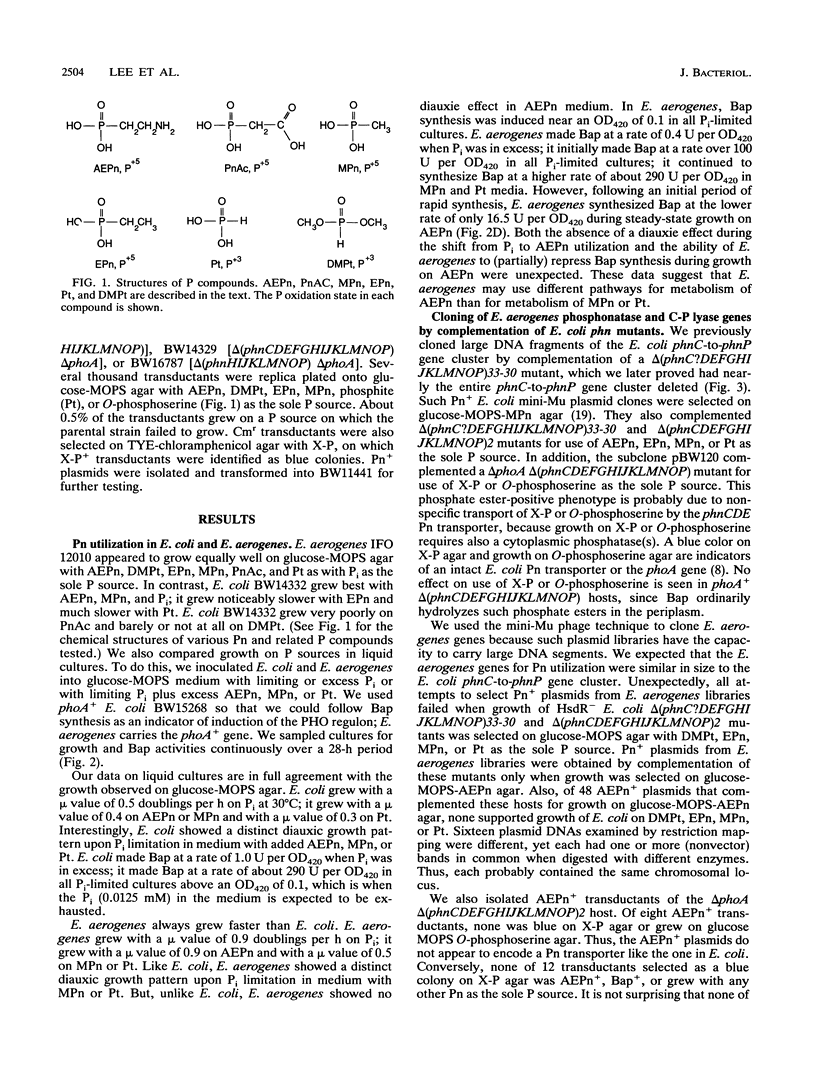
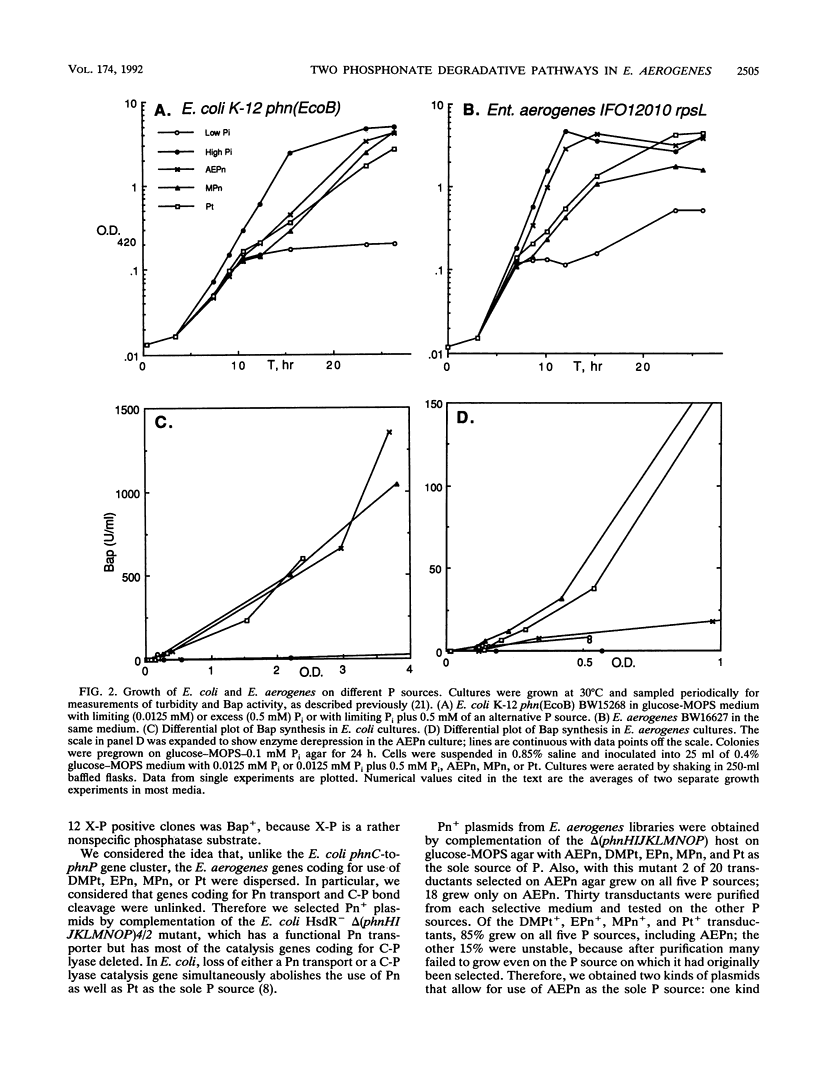
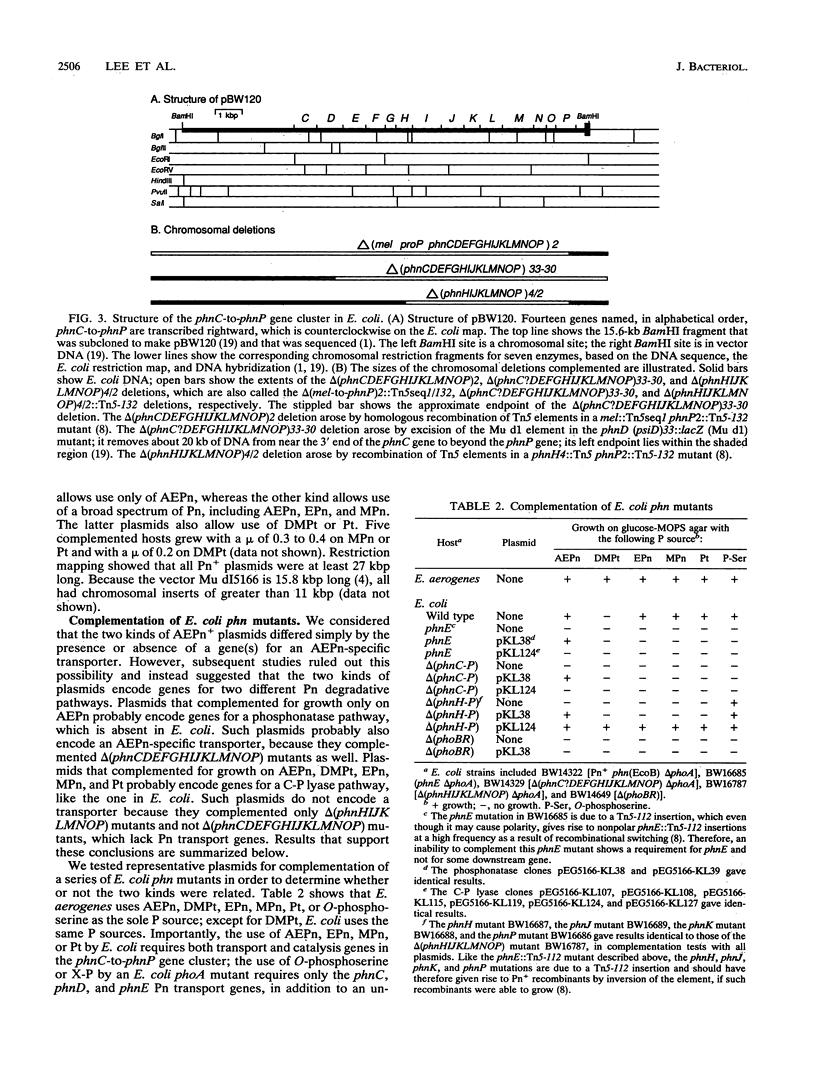
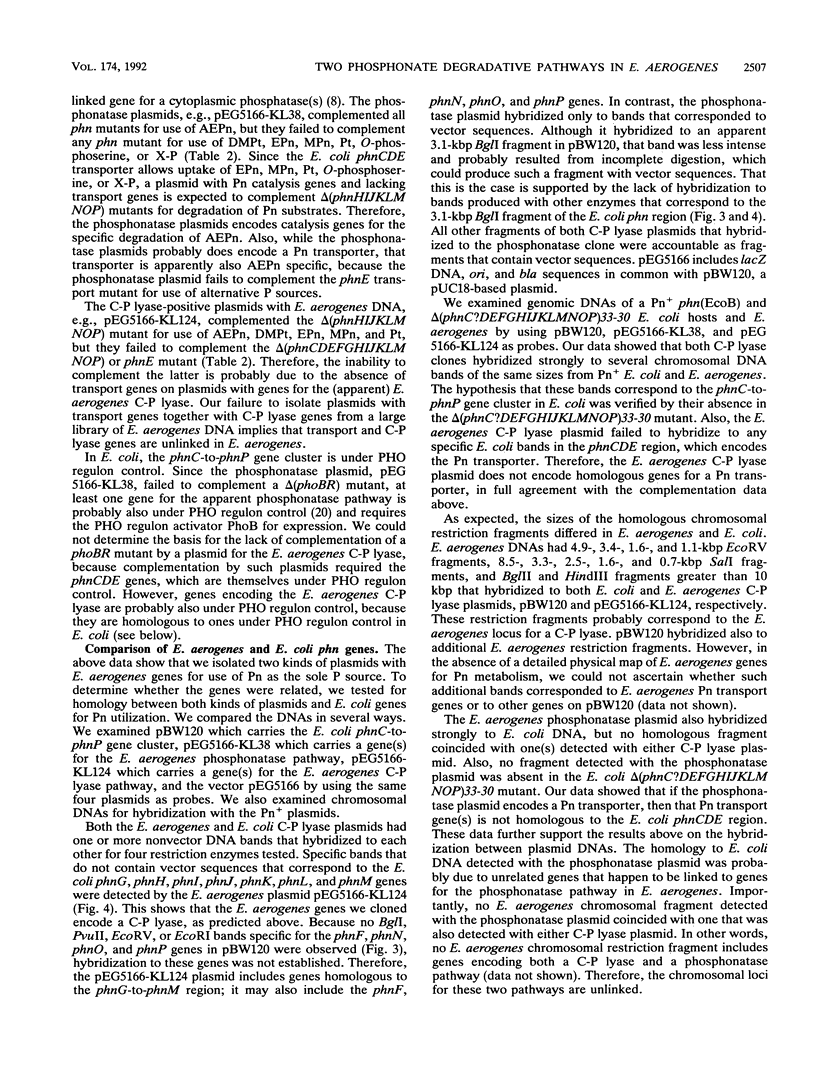
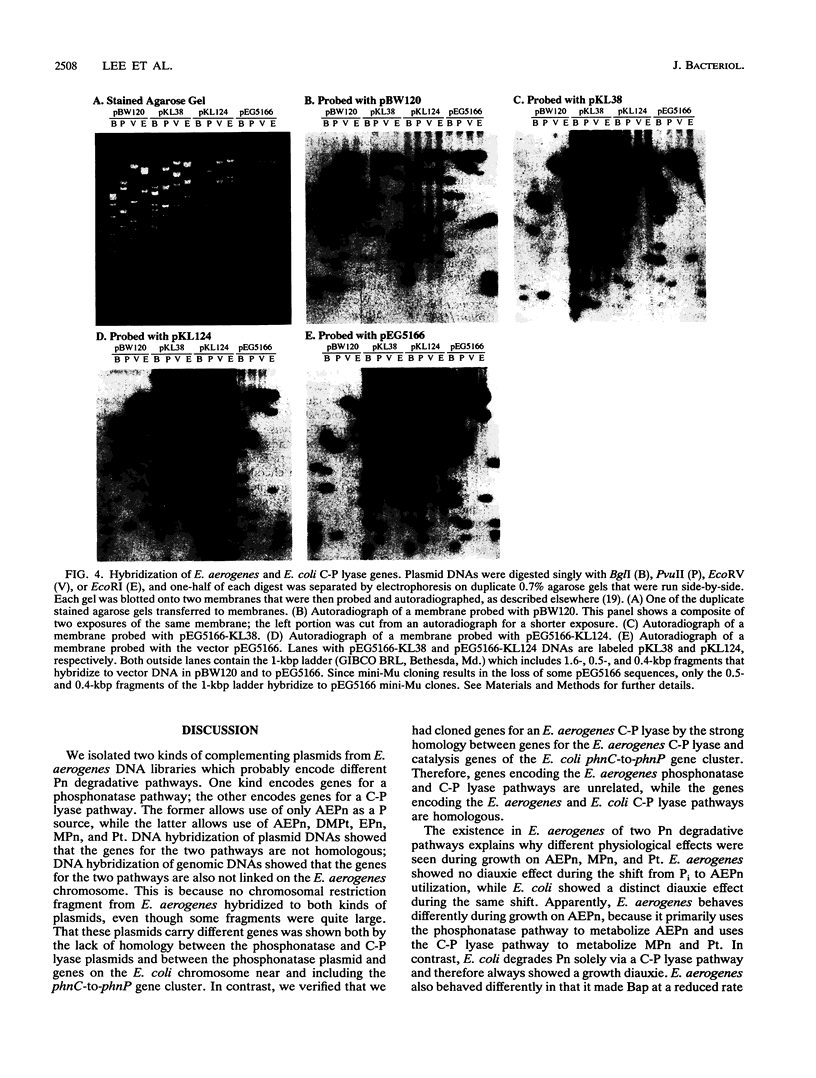
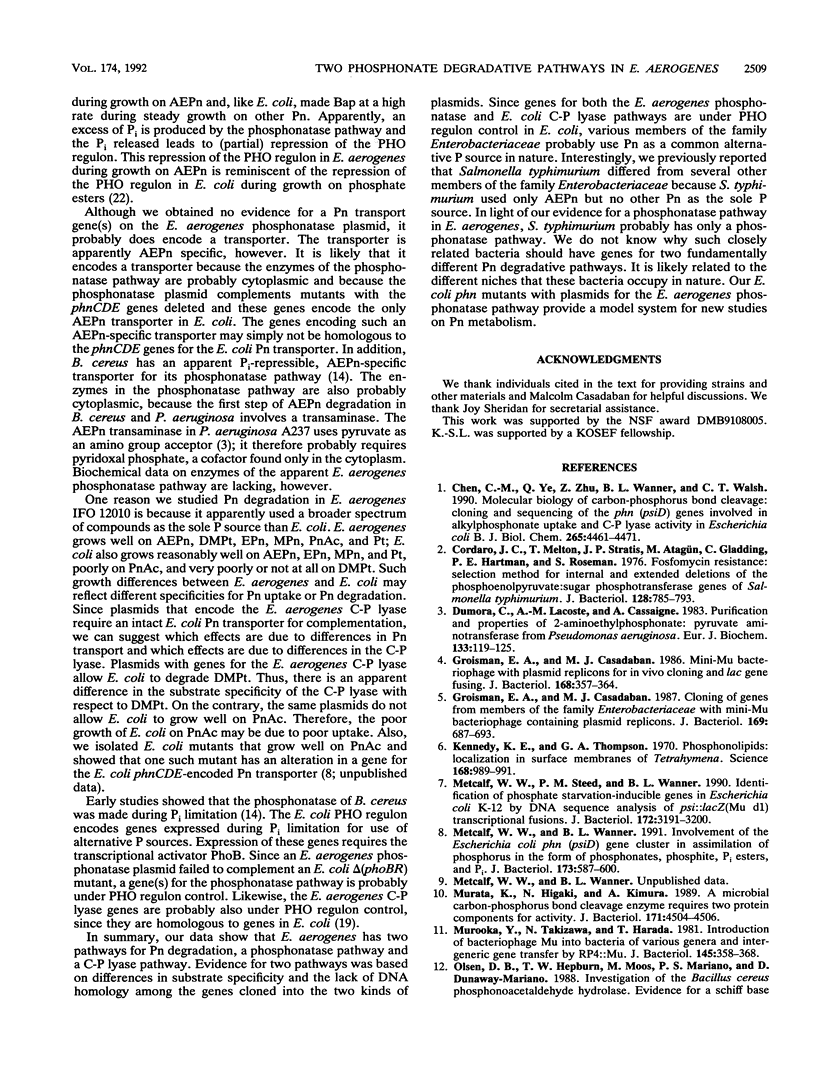
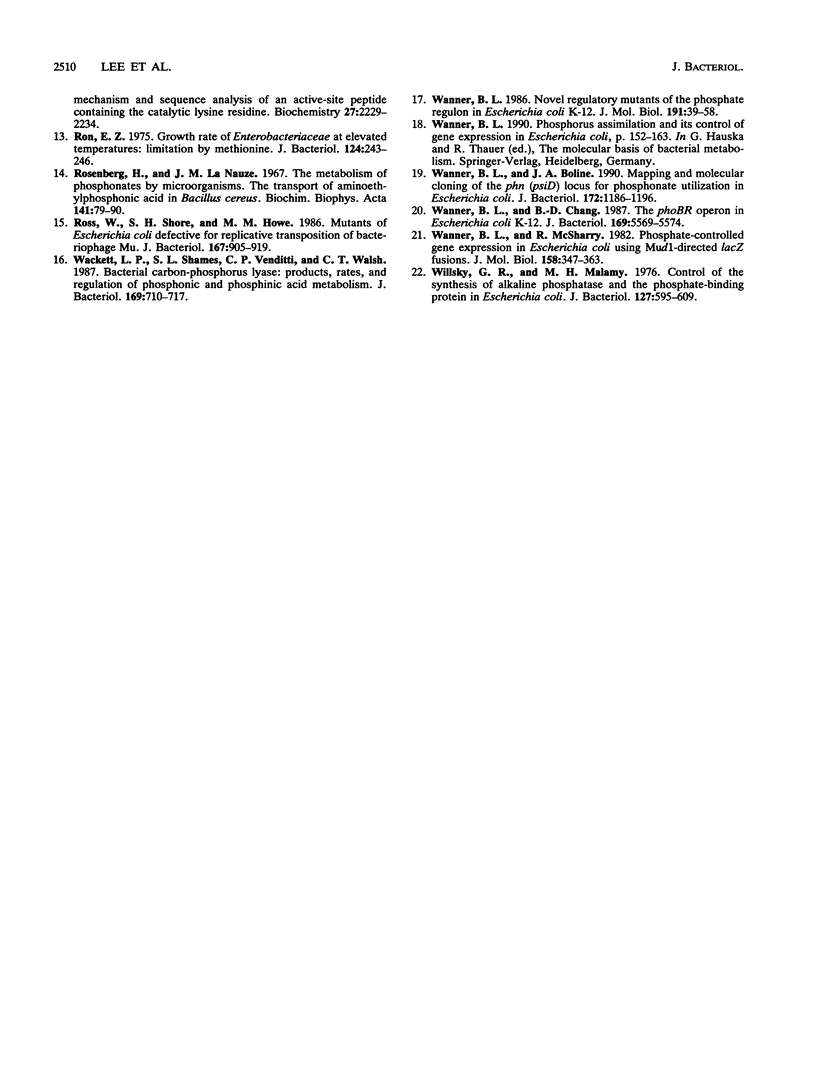
Images in this article
Selected References
These references are in PubMed. This may not be the complete list of references from this article.
- Chen C. M., Ye Q. Z., Zhu Z. M., Wanner B. L., Walsh C. T. Molecular biology of carbon-phosphorus bond cleavage. Cloning and sequencing of the phn (psiD) genes involved in alkylphosphonate uptake and C-P lyase activity in Escherichia coli B. J Biol Chem. 1990 Mar 15;265(8):4461–4471. [PubMed] [Google Scholar]
- Cordaro J. C., Melton T., Stratis J. P., Atagün M., Gladding C., Hartman P. E., Roseman S. Fosfomycin resistance: selection method for internal and extended deletions of the phosphoenolpyruvate:sugar phosphotransferase genes of Salmonella typhimurium. J Bacteriol. 1976 Dec;128(3):785–793. doi: 10.1128/jb.128.3.785-793.1976. [DOI] [PMC free article] [PubMed] [Google Scholar]
- Dumora C., Lacoste A. M., Cassaigne A. Purification and properties of 2-aminoethylphosphonate:pyruvate aminotransferase from Pseudomonas aeruginosa. Eur J Biochem. 1983 Jun 1;133(1):119–125. doi: 10.1111/j.1432-1033.1983.tb07436.x. [DOI] [PubMed] [Google Scholar]
- Groisman E. A., Casadaban M. J. Cloning of genes from members of the family Enterobacteriaceae with mini-Mu bacteriophage containing plasmid replicons. J Bacteriol. 1987 Feb;169(2):687–693. doi: 10.1128/jb.169.2.687-693.1987. [DOI] [PMC free article] [PubMed] [Google Scholar]
- Groisman E. A., Casadaban M. J. Mini-mu bacteriophage with plasmid replicons for in vivo cloning and lac gene fusing. J Bacteriol. 1986 Oct;168(1):357–364. doi: 10.1128/jb.168.1.357-364.1986. [DOI] [PMC free article] [PubMed] [Google Scholar]
- Kennedy K. E., Thompson G. A., Jr Phosphonolipids: localization in surface membranes of Tetrahymena. Science. 1970 May 22;168(3934):989–991. doi: 10.1126/science.168.3934.989. [DOI] [PubMed] [Google Scholar]
- Metcalf W. W., Steed P. M., Wanner B. L. Identification of phosphate starvation-inducible genes in Escherichia coli K-12 by DNA sequence analysis of psi::lacZ(Mu d1) transcriptional fusions. J Bacteriol. 1990 Jun;172(6):3191–3200. doi: 10.1128/jb.172.6.3191-3200.1990. [DOI] [PMC free article] [PubMed] [Google Scholar]
- Metcalf W. W., Wanner B. L. Involvement of the Escherichia coli phn (psiD) gene cluster in assimilation of phosphorus in the form of phosphonates, phosphite, Pi esters, and Pi. J Bacteriol. 1991 Jan;173(2):587–600. doi: 10.1128/jb.173.2.587-600.1991. [DOI] [PMC free article] [PubMed] [Google Scholar]
- Murata K., Higaki N., Kimura A. A microbial carbon-phosphorus bond cleavage enzyme requires two protein components for activity. J Bacteriol. 1989 Aug;171(8):4504–4506. doi: 10.1128/jb.171.8.4504-4506.1989. [DOI] [PMC free article] [PubMed] [Google Scholar]
- Murooka Y., Takizawa N., Harada T. Introduction of bacteriophage Mu into bacteria of various genera and intergeneric gene transfer by RP4::Mu. J Bacteriol. 1981 Jan;145(1):358–368. doi: 10.1128/jb.145.1.358-368.1981. [DOI] [PMC free article] [PubMed] [Google Scholar]
- Ron E. Z. Growth rate of Enterobacteriaceae at elevated temperatures: limitation by methionine. J Bacteriol. 1975 Oct;124(1):243–246. doi: 10.1128/jb.124.1.243-246.1975. [DOI] [PMC free article] [PubMed] [Google Scholar]
- Rosenberg H., La Nauze J. M. The metabolism of phosphonates by microorganisms. The transport of aminoethylphosphonic acid in Bacillus cereus. Biochim Biophys Acta. 1967 Jun 13;141(1):79–90. doi: 10.1016/0304-4165(67)90247-4. [DOI] [PubMed] [Google Scholar]
- Ross W., Shore S. H., Howe M. M. Mutants of Escherichia coli defective for replicative transposition of bacteriophage Mu. J Bacteriol. 1986 Sep;167(3):905–919. doi: 10.1128/jb.167.3.905-919.1986. [DOI] [PMC free article] [PubMed] [Google Scholar]
- Wackett L. P., Shames S. L., Venditti C. P., Walsh C. T. Bacterial carbon-phosphorus lyase: products, rates, and regulation of phosphonic and phosphinic acid metabolism. J Bacteriol. 1987 Feb;169(2):710–717. doi: 10.1128/jb.169.2.710-717.1987. [DOI] [PMC free article] [PubMed] [Google Scholar]
- Wanner B. L., Boline J. A. Mapping and molecular cloning of the phn (psiD) locus for phosphonate utilization in Escherichia coli. J Bacteriol. 1990 Mar;172(3):1186–1196. doi: 10.1128/jb.172.3.1186-1196.1990. [DOI] [PMC free article] [PubMed] [Google Scholar]
- Wanner B. L., Chang B. D. The phoBR operon in Escherichia coli K-12. J Bacteriol. 1987 Dec;169(12):5569–5574. doi: 10.1128/jb.169.12.5569-5574.1987. [DOI] [PMC free article] [PubMed] [Google Scholar]
- Wanner B. L., McSharry R. Phosphate-controlled gene expression in Escherichia coli K12 using Mudl-directed lacZ fusions. J Mol Biol. 1982 Jul 5;158(3):347–363. doi: 10.1016/0022-2836(82)90202-9. [DOI] [PubMed] [Google Scholar]
- Wanner B. L. Novel regulatory mutants of the phosphate regulon in Escherichia coli K-12. J Mol Biol. 1986 Sep 5;191(1):39–58. doi: 10.1016/0022-2836(86)90421-3. [DOI] [PubMed] [Google Scholar]
- Willsky G. R., Malamy M. H. Control of the synthesis of alkaline phosphatase and the phosphate-binding protein in Escherichia coli. J Bacteriol. 1976 Jul;127(1):595–609. doi: 10.1128/jb.127.1.595-609.1976. [DOI] [PMC free article] [PubMed] [Google Scholar]



